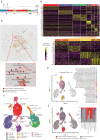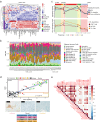Converging and evolving immuno-genomic routes toward immune escape in breast cancer
- PMID: 38383522
- PMCID: PMC10882008
- DOI: 10.1038/s41467-024-45292-1
Converging and evolving immuno-genomic routes toward immune escape in breast cancer
Abstract
The interactions between tumor and immune cells along the course of breast cancer progression remain largely unknown. Here, we extensively characterize multiple sequential and parallel multiregion tumor and blood specimens of an index patient and a cohort of metastatic triple-negative breast cancers. We demonstrate that a continuous increase in tumor genomic heterogeneity and distinct molecular clocks correlated with resistance to treatment, eventually allowing tumors to escape from immune control. TCR repertoire loses diversity over time, leading to convergent evolution as breast cancer progresses. Although mixed populations of effector memory and cytotoxic single T cells coexist in the peripheral blood, defects in the antigen presentation machinery coupled with subdued T cell recruitment into metastases are observed, indicating a potent immune avoidance microenvironment not compatible with an effective antitumor response in lethal metastatic disease. Our results demonstrate that the immune responses against cancer are not static, but rather follow dynamic processes that match cancer genomic progression, illustrating the complex nature of tumor and immune cell interactions.
© 2024. The Author(s).
Conflict of interest statement
L.D.M.A. has received honoraria for participation in a speaker’s bureau/ consultancy from Roche and reports research collaboration and support from NanoString Technologies, Education grant: BMS, Lilly. L.D.M.A. is currently employed by BioNTech SE. H.H. is co-founder and shareholder of Omniscope, SAB member of Nanostring and MiRXES, and consultant to Moderna and Singularity. C.A.S. is a scientific associate of Dataomics Biotech. J.B.H. is currently affiliated with the Marie-Josée and Henry R. Kravis Center for Molecular Oncology, Memorial Sloan Kettering Cancer Center, New York, NY, USA. J.S.R.-F. reports receiving personal/consultancy fees from Goldman Sachs, Bain Capital, REPARE Therapeutics, Saga Diagnostics, MultiplexDX, and Paige.AI, membership of the scientific advisory boards of VolitionRx, REPARE Therapeutics and Paige.AI, membership of the Board of Directors of Grupo Oncoclinicas, and ad hoc membership of the scientific advisory boards of AstraZeneca, Merck, Daiichi Sankyo, Roche Tissue Diagnostics and Personalis, outside the scope of this study. J.S.R.-F. is currently employed by AstraZeneca. B.W. reports research funding from Repare Therapeutics, outside the scope of the submitted work. The other authors declare no competing interests.
Figures





Similar articles
-
The Genomic and Immune Landscapes of Lethal Metastatic Breast Cancer.Cell Rep. 2019 May 28;27(9):2690-2708.e10. doi: 10.1016/j.celrep.2019.04.098. Cell Rep. 2019. PMID: 31141692 Free PMC article.
-
Genetic Heterogeneity, Tumor Microenvironment and Immunotherapy in Triple-Negative Breast Cancer.Int J Mol Sci. 2022 Nov 29;23(23):14937. doi: 10.3390/ijms232314937. Int J Mol Sci. 2022. PMID: 36499265 Free PMC article. Review.
-
Multi-Omics Profiling Reveals Distinct Microenvironment Characterization and Suggests Immune Escape Mechanisms of Triple-Negative Breast Cancer.Clin Cancer Res. 2019 Aug 15;25(16):5002-5014. doi: 10.1158/1078-0432.CCR-18-3524. Epub 2019 Mar 5. Clin Cancer Res. 2019. PMID: 30837276
-
Heterogeneity of breast cancer: The importance of interaction between different tumor cell populations.Life Sci. 2019 Dec 15;239:117009. doi: 10.1016/j.lfs.2019.117009. Epub 2019 Oct 24. Life Sci. 2019. PMID: 31669239 Review.
-
Comprehensive genomic and immunophenotypic analysis of CD4 T cell infiltrating human triple-negative breast cancer.Cancer Immunol Immunother. 2021 Jun;70(6):1649-1665. doi: 10.1007/s00262-020-02807-1. Epub 2020 Dec 10. Cancer Immunol Immunother. 2021. PMID: 33301062 Free PMC article.
Cited by
-
Discovery of oxazine-linked pyrimidine as an inhibitor of breast cancer growth and metastasis by abrogating NF-κB activation.Front Oncol. 2024 Jul 29;14:1390992. doi: 10.3389/fonc.2024.1390992. eCollection 2024. Front Oncol. 2024. PMID: 39135991 Free PMC article.
-
Single-cell and spatial omics unravel the spatiotemporal biology of tumour border invasion and haematogenous metastasis.Clin Transl Med. 2024 Oct;14(10):e70036. doi: 10.1002/ctm2.70036. Clin Transl Med. 2024. PMID: 39350478 Free PMC article. Review.
-
Variation in bulk RNA-seq and estimated cell type proportion using deconvolution when comparing pancreatic cancer samples within the same individual.medRxiv [Preprint]. 2025 May 6:2025.05.05.25326976. doi: 10.1101/2025.05.05.25326976. medRxiv. 2025. PMID: 40385431 Free PMC article. Preprint.
-
Distinct evolutionary patterns of tumour-immune escape and elimination determined by extracellular matrix architectures.J R Soc Interface. 2025 Jul;22(228):20250116. doi: 10.1098/rsif.2025.0116. Epub 2025 Jul 9. J R Soc Interface. 2025. PMID: 40631902 Free PMC article.
-
CD4+FOXP3Exon2+ regulatory T cell frequency predicts breast cancer prognosis and survival.Sci Adv. 2025 Jan 17;11(3):eadr7934. doi: 10.1126/sciadv.adr7934. Epub 2025 Jan 15. Sci Adv. 2025. PMID: 39813341 Free PMC article.
References
MeSH terms
Grants and funding
LinkOut - more resources
Full Text Sources
Medical

